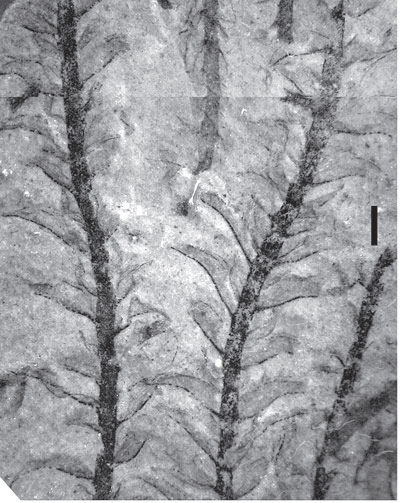Mosses (Bryophytes) are simple plants which lack vascular systems to pump water and nutrients from a root system, instead relying on what they can absorb through their leaves, and generally only reaching a few cm in height. This means that they are at their most diverse in moist habitats, though some species are surprisingly drought-tolerant. Despite their simple nature, Mosses are an important part of ecosystems the world over, creating a water-holding layer which covers soil, rocks, trees and some animals, inside which entire miniature communities of organisms thrive. Mosses also differ from vascular plants in that they are haploid (have one set of chromosomes) rather than diploid (have paired chromosomes); though they have a diploid spore stage used to propagate the species in the same way that the (haploid) pollen of vascular plants is.
In a paper published in the journal Palaeontology in January 2012, Isabel Cortez Christiano de Souza and Fresia Ricardi Branco of the Department of Geosciences and Natural Resources at the Institute of Geosciences at the State University of Campinas and Yelitza León Vargas of the Centro Jardín Botánico at the Facultad de Ciencias at the Universidad de Los Andes describe two new species of Moss from the Middle Permian Teresina Formation, found in the Rio Preto Quarry, in the state of Paraná in Brazil. Mosses from the Permian are not unexpected, since they are thought to be one of the oldest groups of plants to have colonized the land, possibly dating back as far as the Ordovician, but they are not well known from the former Gondwana Supercontinent (of which South America forms a part), despite the flora of the widespread Glossopteris forests of the time being well studied on several continents.
The location and geological setting of the Rio Preto Quarry. Christiano de Souza et al. (2012).
The first new species of Moss is named Capimirinus riopretensis, where Capimirinus is a Latinization of capim mirin, which means small delicate plant in the Tupi-Guarani language, and riopretensis derives from the Rio Preto Quarry. Capimirinus riopretensis grew up to 25 mm in length, with stems that narrow towards the tips, showing dichotomous branching (branching by splitting into two equal parts in a 'Y' shape, as opposed to growing side-branches from existing stems), with erect, spirally arranged leaves and a sporophyte (diploid reproductive structure) produced on a pleurocarp (short side branch).
Capimirinus riopretensis. Scale bar 5 mm in top left image, 1 mm in all other images. Christiano de Souza et al. (2012).
The second new species described is named Yguajemanus yucapirus, meaning the Old Moss of Death in Tupi-Guarani. This has branching stems of a constant thickness and strongly curved leaves aranged in symmetrical pairs.
Yguajemanus yucapirus. Christiano de Souza et al. (2012).
See also A Permian forest preserved in volcanic ash, Russian scientists germinate Pleistocene seeds, Insect borings in Triasic wood, Did the first land plants cause an Ordovician glaciation? and The end of the Permian.
Follow Sciency Thoughts on Facebook.



